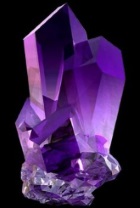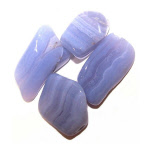
Agate:
Taking its name from the Achates River, where Greek philosopher Theophrastus found
examples, Agate is a chalcedony, a form of silica often found in volcanic rocks.
Agate is found in many colours and varieties, forming either contrasting lines, cloudy patches of fern-like patterns.
Agate has been used as a “Truth Stone”, and to enhance courage and protect against danger.
It is the Gemini birthstone
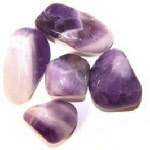
Amethyst:
A variety of Quartz, gaining its distinctive violet colour from iron impurities, trace elements and irradiation. The name comes from the Greek “a-” (‘not’), “methustos” (drunkenness), a reference to the belief that it protected the wearer from intoxication.
It is said that placing an Amethyst under ones pillow will guard against insomnia, and is used by Crystal Healers, particularly for cleansing Negativity, and bathing them in Moonloght to instil calmness in a home.
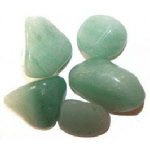
Aventurine:
From the Italian “a ventura” or “by chance”, Aventurine’s green hue is caused by Chomium inclusions which also give it a shimmering, glistening effect, termed “aventuresence”.
Almost all aventurine is found in India, where artisans carve it into beads and figurines, with only the finest examples being made into cabochons for use in jewellery.
Placing an aventurine in your left pocket is professed to increase your Luck, and also enhance ones perception and creative insight.
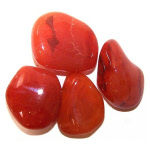
Carnelian:
Tracing its name back to the Latin cornum (Cornel Cherry), this stone varies from a yellow-orange to reddish-brown, and is known to have been used decoratively for nearly 4,000 years.
It found a use in Ancient Rome for Signet Rings and Seals, for hot wax does not stick to Carnelian, leaving the Seal well-formed.
Ancient Egyptians would carry Carnelian to refresh their vigour and vitality, and their “Book Of The Dead” mentions its use as ‘magic armour’ for the deceased.
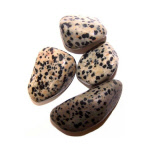
Dalmatian:
Dalmatian Stones are normally a light-coloured Jasper, with black or brown spots, resembling the dog from which they take their name. They are more often found in India, and are worked into jewellery and ornaments.
The birthstone of Virgo, it is said to strengthen family ties and impart a calm tranquility on a home. In a similar manner, it encourages team building amongst work colleagues.
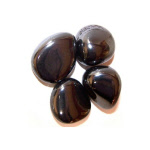
Hematite:
A rhombohedral crystal of Ferrous Oxide (Fe2O3), Hematite is usually black-to-steel-grey, with a reddish tint. Some forms are very red, leading to its name, derived from the Greek for blood (haima).
The main source for Hematite is in Brazil, although many other substantial deposits are known, and it has even been found on Mars!
Hematite has been linked with courage, strength and endurance, and also to mental fortitude, concentration and memory.
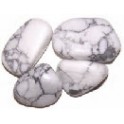
Howlite:
Named for its discoverer, Henry How, this white, veined stone is a calcium borosilicate hydroxide. Generally found in Nova Scotia and California, its porous nature makes it easy to dye, giving rise to many variations.
Carved into a sphere, pyramid or wand, Crystal Healers use Howlite for its calming effect, helping to absorb anger and stress, and also improving access to past-lives and memories.
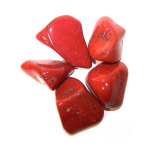
Jasper:
From jaspre (Old French, “Speckeld Stone”, which traces its roots back to Akkadian yashupu), this opaque rock is a type of chalcedony, a form of silica made with quartz and moganite.
Jasper occurs in many colours, with many styles of pattern, giving rise to a wide variety of stones.
Certain Feng Shui practitioners hold that the earthy, nourishing essence of jasper helps to provide energy, vitality and determination.
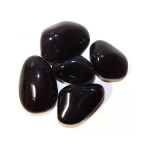
Obsidian:
Not actually a “crystal” as such, this volcanic glass is formed from cooling lava. It takes its name from the Ancient Roman explorer Obsius, who brought it back from his travels to Ethiopia. It has been prized since prehistoric times for its ability to be worked into razor-sharp edges.
This sharpness has led to it being called the “Stone of Truth”, able to cut through the most powerful illusions and lies. Some say that this even extends to the Wearer, revealing to them parts of themselves that they would rather not face.
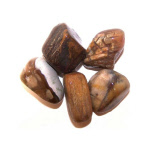
Petrified Wood:
Again, not really a “crystal”, although it does have a crystal-like structure, this is wood that has had its organic elements replaced by agate as it rots away. The structure is maintained as it fossilises, as can be seen in the beautiful patterns through it.
Because of its origins in a living tree, these ancient stones are said to aid in the channeling of nature Spirits, and to help those who would protect the Environment.

Quartz:
One of the most common minerals on earth, found all over the planet, and available in many colours and hues, quartz is valued for both its beauty and utility.
Due to its ubiquitous nature, quartz has been endowed with many Spiritual properties, including the ability to store, balance, focus and transmit energy, and to be beneficial in healing and meditation.
As there are so many types, colours and shapes, it has been referred to as the “Universal Crystal”.
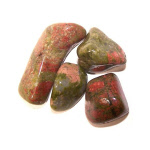
Unakite:
A form of altered granite composed of pink feldspar, green epidote and clear quartz, Unakite takes its name from the Unakas Mountains, USA, where it was first found.
The birthstone of Scorpio, it is said that Unakite supports recovery and convalescence, while also helping with pregnancy and facilitating the health of unborn babies.
It is also claimed to help protect against ‘electromagnetic fog’, and placing Unakite on or near TV sets, Wi-Fi routers and the like is recommended.
